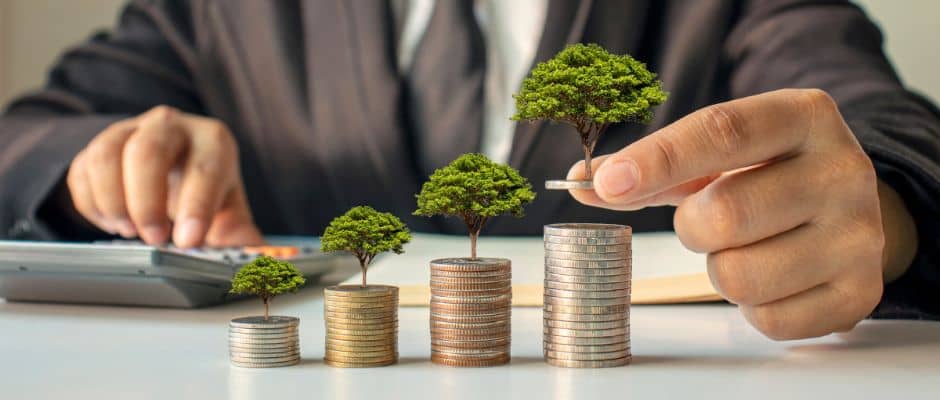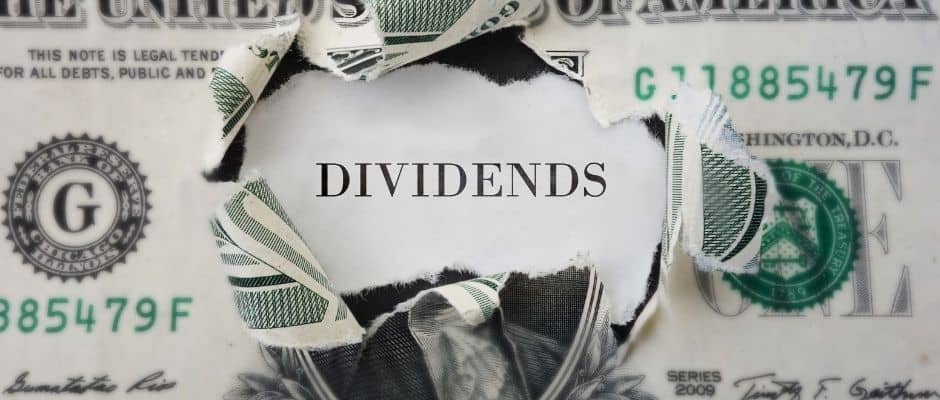So you’re scrolling through social media and come across investors who tout dividends as the key to financial freedom. Really? Dividends? Those things that boring value stocks pay out four times per year? Why would you want to invest so much money to get paid a minimal amount every three months? And why do they keep talking about the dividend yield? What is dividend yield and why should you even care?
The dividend yield is a polarizing topic in the personal finance and investing communities. Some investors swear by it while others could care less what the yield is.
This article is going to dive deep into the world of dividends. Specifically, we’ll be looking at the dividend yield and explaining why you should, or shouldn’t, take the yield into account when considering investing in a stock or ETF.
What is Dividend Yield?
The dividend yield is a financial ratio that measures the percentage of the stock’s price that is paid out as dividends each year. Since it is tied to the price of the company’s stock, the dividend yield will fluctuate as the share price changes. Generally speaking, as the stock price falls the dividend yield rises and vice versa.

However, the dividend yield is a measure of other financial metrics as well. Perhaps most importantly, it provides insight into how much cash-generating potential the company has. A healthy yield shows that the company’s cash flow is strong and it anticipates it will stay that way for the foreseeable future.
This is why most dividends are paid out by blue-chip value stocks. Not only do these companies have strong cash flow but their stock prices are steady, which means that the dividend yield will be too.
How to Calculate Dividend Yield
As far as financial ratios go, the dividend yield is fairly straightforward to calculate.
Here is the formula to calculate the dividend yield of a stock or ETF:
Dividend Yield = (Annual Dividend per Share / Stock Price) * 100
Here’s what the formula means for calculating a dividend yield:
- Annual Dividend per Share: The annual dividend per share number is the total dollar value of dividends that shareholders will receive in one year. Another way to think about this is the total amount of dividends the company pays out divided by the total number of outstanding shares.
- Stock Price: This is the current market price of one share of the underlying stock. Since this price changes each day, it will have a direct impact on the dividend yield as well.
This formula will provide you with the dividend yield for the stock or ETF. When you multiply it by 100, it will provide you with the dividend yield expressed as a percentage.
Why is the Dividend Yield Important?
Despite what some people will say, the yield does serve a purpose for investors. It is not a completely irrelevant metric at all. Here are some of the reasons why the dividend yield is important to investors.
- Generating Income for Shareholders: This is the main reason why we as investors will buy dividend-paying assets. What dictates how much income we can generate? The dividend yield. Generating income through dividends is something that retirees or those approaching retirement can focus on. Younger investors should focus more on growth and capital appreciation.
- To Compare Potential Investments: Dividend yields can be used to compare the relative value of stocks against each other, especially in the same industry or sector.
- Measure of Financial Health: Companies that pay out dividends to shareholders are typically very strong financially with good cash flows and revenues, with a solid balance sheet.
- Market or Investor Sentiment: A drastic change in a stock’s dividend yield could be a sign of a shift in market sentiment for the company. Remember, when the stock price falls, the yield rises. As alluring as they are many people see higher dividend yields as a potential red flag.
- Investor Expectations: A strong dividend yield history can be seen as another sign of the company’s strength. If the company continues to raise its dividend, the stock will likely become more attractive to investors.

What Does the Dividend Yield Mean?
The dividend yield is not just about paying out dividends. It is a telling metric about the financial health and stability of a business. Here are a few ways to interpret what a dividend yield means:
- High Dividend Yield Trap: Do not fall for the dividend yield trap. When a company’s dividend yield is suddenly higher it does not mean it is making more money. In fact, what this usually means is that the stock price has fallen. Make sure a high yield is sustainable before investing in a company simply for its dividends.
- Cyclical Industries: Did you know that cyclical companies see their dividend yield fluctuate over time? In these industries, the profitability and cash flow can be volatile. Make sure you know where a company is in their business cycle before diving into a stock.
- Dividend Cuts: Yes! A company can cut its dividend yield as well! This is a major red flag and a sign that the company is not doing well financially. Always be aware of the sustainability of the dividend for that particular company.
- Growth vs. Income: Is dividend investing the way to go? Depending on your age and risk tolerance, you might actually be better off investing in growth stocks for capital appreciation. Most growth stocks do not pay out a dividend but have the potential to far outperform a quarterly dividend distribution.
What Affects the Dividend Yield?
A stock’s dividend yield is always fluctuating. Since it is tied directly to the stock’s price, it can be affected by a number of different things.
- Profitability and Cash Flow: Not many unprofitable companies will pay out a dividend. This is because, without proper free cash flow, it would be a complete waste of money. If a company stops being profitable, it will likely stop paying out its dividend as well.
- Dividend Policies: You should know the dividend policies of each company you invest in. Some companies will prioritize the dividend while others could not care less about it. New leadership can also disrupt the stock’s dividend yield if their dividend policies change.
- Market Conditions: Any changes in market sentiment could have a direct impact on the dividend yield. In a bear market, stock prices tend to fall which will cause the dividend yield to spike.
- Interest Rates: Generally speaking, when interest rates are low, people are more inclined to be investing in equities. When interest rates are high, equities are likely volatile so investors will be more attracted to fixed-income assets like bonds.

What is a Good Dividend Yield?
Ah, the golden question for dividend investors: What is a good dividend yield? Here’s another reminder to not chase yield when it comes to stocks as it is usually a financial red flag.
Historically, the stocks in the S&P 500 have had an average dividend yield of between 2-5%. Would you be happy with that yield? Remember that dividend yields are always relative to the price of the stock. A 10% yield for a $10.00 stock is not the same as a 5% yield for a $100.00 stock.
If the asset you are investing in has a high yield, do some research. You should be skeptical of high yields from individual companies. High yields from ETFs through strategies like covered calls can be risky but aren’t always as risky as some will lead on. If you are interested in learning about some high-dividend yielding ETFs, check out our JEPI Review below:
The Bottom Line: How Important is the Dividend Yield?
The dividend yield is an important metric but shouldn’t be the only reason you invest in a stock or ETF. What the yield tells us is how much in dividends the asset is paying relative to its current price. Generally speaking, the higher the yield the higher the risk.
Ultimately, a good dividend yield is in the eye of the investor. Only you know how much risk you want to take on if you are chasing high dividend yields from companies. Remember that higher yields for ETFs aren’t always the same as high-yielding stocks.
If you want to invest by a rule of thumb, always look back to the S&P 500. Over time, the average dividend yield for all of the dividend-paying stocks in the index has had a yield of between 2-5%.
We hope this discussion on the dividend yield helped you learn a little more about investing in dividends. As always, this is not meant to be financial advice, but rather an introduction to the basics of a stock’s dividend yield.
Stay Savvy!
